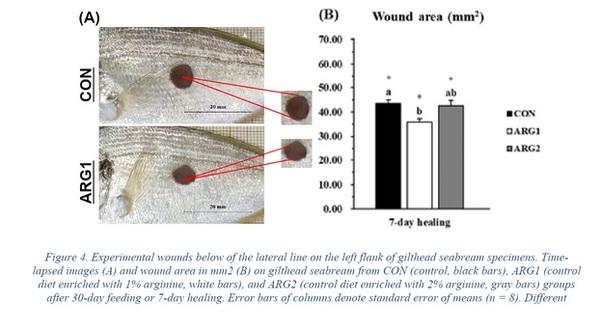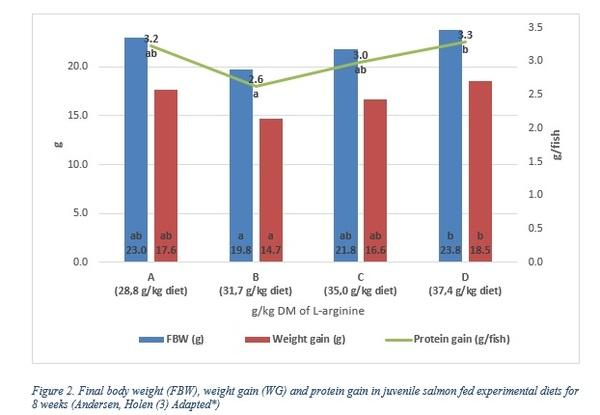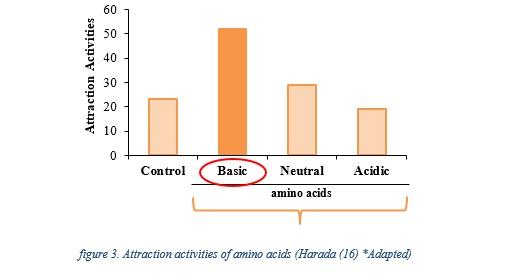INTRODUCTION
Among the essential amino acids (AA), L-arginine (ARG) is one of the functional amino acids in animals. ARG is a nutritionally very important and essential AA for fish, and is considered the fourth limiting AA in aquafeed. Most of fish species excretes ammonia predominantly through the gills, diffusing NH 3 or NH 4 (ammoniotelic animals). Therefore, unlike mammals, fish have a low hepatic activity of carbamoyl phosphate synthase III or ornithine carbamoyl transferase, therefore they cannot synthesize arginine (1, 2) . Thus, fish depend on ARG in their diet to meet their protein synthesis needs and among other diverse functions. ARG requirement in fish ranges between 3.0 and 8.1% of dietary protein.
In addition to this AA being essential for fish growth and survival and being used as a protein building block, it is also involved in several important physiological and metabolic functions (3) . Several studies carried out with this AA have demonstrated different functions, which include in improvement in reproductive function (4) , endocrine functions (5) , reduction in oxidative stress and fat (3) , improving skin and integuments (6) , and improving immune function (7) . Furthermore, ARG has been shown to be a precursor for the biosynthesis of many important molecules, including proteins, glutamine, glutamate, proline, ornithine, and several hormones (7) .
Arginine is also involved in a number of important metabolic processes, including the synthesis of nitric oxide (NO), creatine and polyamines in fish. NO synthesis is carried out by the action of enzymes, nitric oxide synthetase from the amino acid ARG which produces NO and L-citrulline, requiring the presence of two cofactors, oxygen and Nicotinamide Adenine Dinucleotide Phosphate (8) . NO is a potent vasodilator, increasing blood flow to organs and thus allowing greater absorption of nutrients for oxidation (9) . In addition, NO is an antioxidant and is related to various systems in the body, such as the cardiovascular system, the reproductive system, in addition to participating in the facilitation of neurological function, cell signaling, regulation of osmolality and macrophage activation in fish (10) .
Arginine can also increase the transport of long-chain fatty acids to β-oxidation via the NO pathway. NO can inhibit acetyl-CoA carboxylase (ACC) by stimulating AMPK phosphorylation or activating guanylyl cyclase, increasing cGMP production, both inhibiting ACC and increasing mitochondrial β-oxidation (13, 14) . NO can also directly increase CPT1 activity (9) . Finally, NO can also increase mitochondrial biogenesis and oxidative phosporylation through cGMP-mediated increased expression of PGC-1α, which may increase the cell's ability to generate ATP (15) .
Arginine on immune function and performance
The crucial role of NO, through l-arginine synthetization, in macrophage activation, plays a fundamental role in innate defense mechanisms, eliminating pathogens and in addition to promoting skin regeneration in fish (7) . In a study conducted with channel catfish, it was observed that increased inclusion of ARG in diets was shown to correlate with survival when fish were exposed to Edwardsiella ictaluria bacteria, which can normally cause sepsis or encephalitis in infected animals (11) . According to Buentello, Reyes-Becerril (12) , higher levels of ARG in the diet of Channel Catfish (Ictalurus punctatus) provided an increase in phagocytosis ( Figure 1 ).

In a study of Atlantic salmon (Salmo salar), plant protein-based diets were fed with increasing ARG inclusions (28.8–37·4 g/kg DM) (3) . According to the results of that study ( Figure 2 ), it was possible to observe that animals fed with diet D (with higher ARG content), had a positive effect on fish performance. Furthermore, fish fed increasing levels of ARG also had an increase in feed intake, indicating that ARG could be a potentially attractive food. The feed attraction may be related to ARG polarity. These results corroborate those observed in a study carried out by Harada (16) , which compared the feed attraction effect between basic, neutral and acidic AAs using a juvenile yellow tail ( figure 3 ). As result, greatest attractive effect was observed in the basic AA group than other amino acid groups, showing a strong feed-attractive effect on ARG.
Arginine on skin and hematological parameters
Skin lesions, abrasions and ulcers, which are common in farmed fish as a result of intensive aquaculture, cause blood loss and contamination of underlying tissues by foreign particles and pathogens. In these situations, skin wounds must be treated quickly to avoid negative impacts on the fish. In a recent study, gilthead seabream was fed a commercial diet (control diet (CON) without added arginine) and a diet supplemented with 1% arginine (ARG1) or 2% arginine (ARG2) (6) . Fish were intentionally injured to assess the effects of ARG on skin wound healing, to provide a possible use of this AA in the healthy management of intensive fish farming. Compared to fish in the CON group after the injury, fish fed the ARG1 diet had a significant increase in the expression of the col1α gene (type I collagen or more abundant collagen in the fish body), which may contribute to improve granulation tissue formation in fish. In addition, fish fed the ARG1 diet showed positive results after injury, including increased peroxidase activity in skin mucus ( Figure 4 ). According to Buentello, Reyes-Becerril (12) , the supplementation with ARG increased the levels of blood parameters and superoxide dismutase ( Table 1 ). Blood parameters are good indicators of fish nutrition, stress and general health. Furthermore, superoxide dismutase is one of the main antioxidant defense pathways in response to oxidative stress. Thus, the results indicated that the dietary administration of ARG strengthens the antioxidant system present in the skin, relieving inflammation in this important organ.



CONCLUSION
Taken together, these data suggest that arginine is one of the most active and versatile amino acids in animal cells and is considered an essential for fish since they cannot synthesize it. ARG is involved in several physiological and metabolic functions in fish, in addition to being a precursor in the biosynthesis of many important molecules, such as the synthesis of nitric oxide. ARG supplementation modulates innate immune mechanisms and may increase phagocytosis in fish. This AA is promising to increase growth, protein deposition in fish and lipid metabolism, and has been shown to have strong feed-attractive effect. Finally, in addition to many other important functions known in fish, ARG supplementation facilitates the healing of skin wounds and prevents systemic inflammatory reactions in fish.















